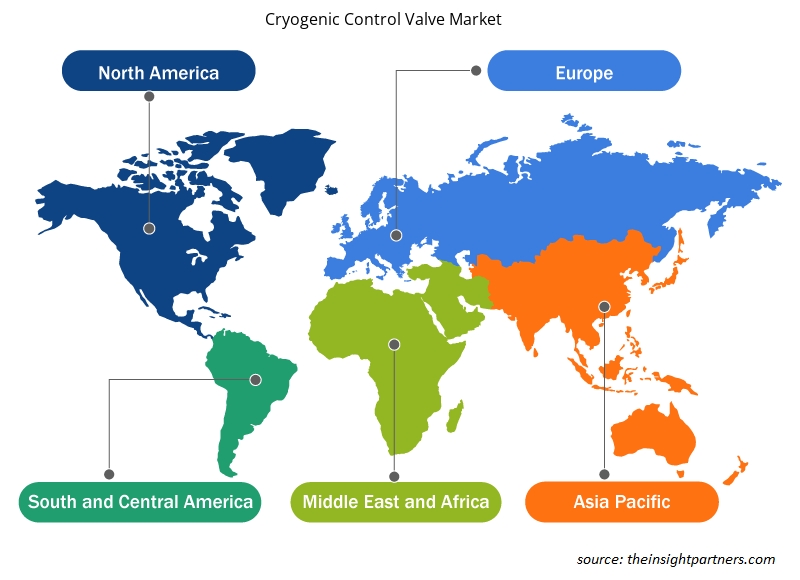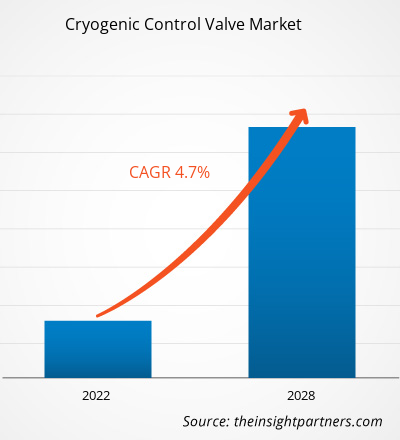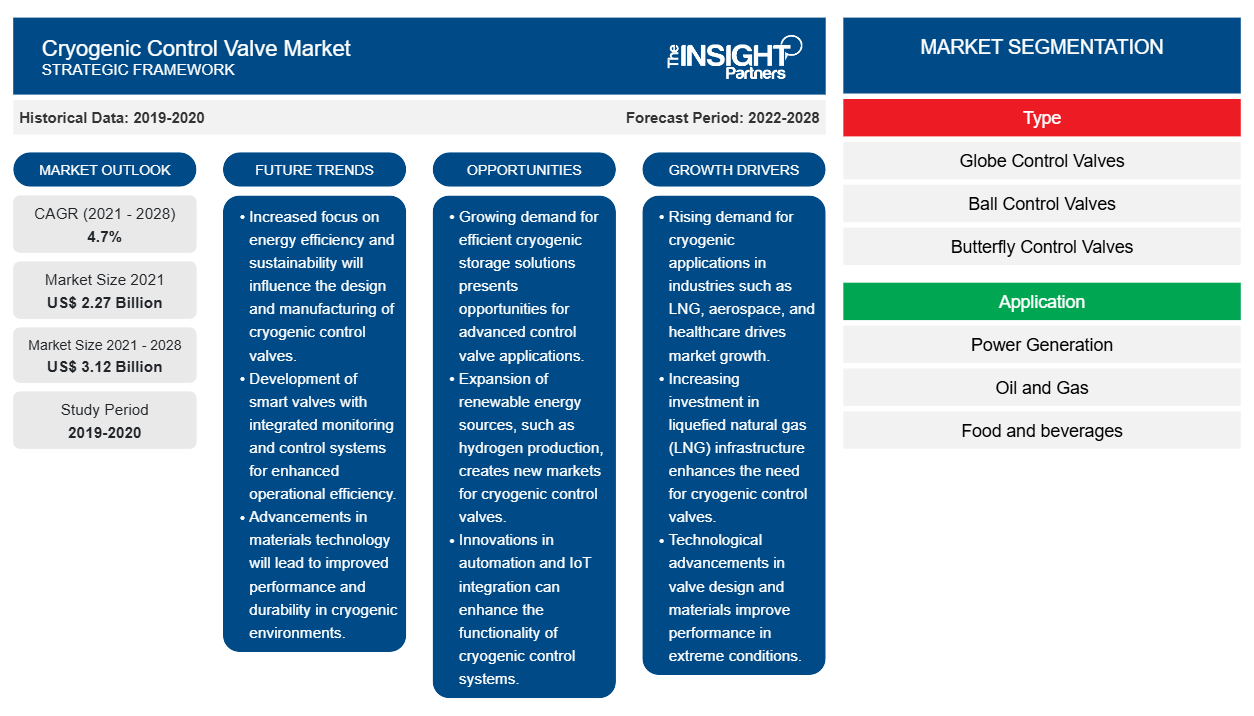Der Markt für kryogene Regelventile soll von 2.267,07 Millionen US-Dollar im Jahr 2021 auf 3.117,79 Millionen US-Dollar im Jahr 2028 wachsen; für den Zeitraum 2021–2028 wird eine durchschnittliche jährliche Wachstumsrate ( CAGR) von 4,7 % geschätzt.
Die Nachfrage nach Industriegasen steigt sowohl in Industrie- als auch in Entwicklungsländern wie Großbritannien, den USA, Australien, Deutschland, Indien und China. Für spezifische Anwendungen in unterschiedlichen Branchen werden verschiedene Industriegase hergestellt. Zu den am häufigsten verwendeten Industriegasen gehören unter anderem Sauerstoff, Stickstoff, Argon, Kohlendioxid, Helium, Wasserstoff und Acetylen. Kryogene Ventile werden häufig für den Transport, die Nutzung und die Lagerung von Flüssiggasen wie komprimiertem Erdgas ( CNG ) und verflüssigtem Erdgas (LNG) verwendet. In Indien verzeichneten die CNG- Autoverkäufe im Geschäftsjahr 2021 ein Wachstum von 49 % im Vergleich zum Vorjahr, und ihr Marktanteil ist von 4 % im Jahr 2020 auf 6 % im Jahr 2021 gestiegen. Die Nachfrage nach Flüssiggasen wie flüssigem Stickstoff steigt in der Kryotherapie zur Entfernung von Hautanomalien, zum Transport und Einfrieren von Lebensmitteln, zur Kühlung von Supraleitern und zur Kryokonservierung von Blut.
Zur Sauerstoffproduktion werden kryogene Ventile in großem Maßstab in Luftzerlegungsanlagen eingesetzt. Der in jüngster Zeit steigende Sauerstoffbedarf ist ebenfalls ein treibender Faktor, der zum Wachstum des Marktes für kryogene Regelventile beiträgt. Die verschiedenen Arten von kryogenen Ventilen, die für die Gasindustrie benötigt werden, sind Schieber, Rückschlagventile, Durchgangsventile, Hubrückschlagventile, Kugelhähne, Quetschventile, Absperrventile, Absperrklappen, Kippscheibenrückschlagventile, Kükenhähne, Membranventile, Sicherheitsventile und Überdruckventile. Mit dem steigenden Bedarf an Industriegasen in verschiedenen Branchen wie Chemie, Petrochemie, Stahlherstellung , Bergbau, Umweltschutz, Metalle, Medizin, Biotechnologie, Pharmazie usw. wird auch die Nachfrage nach den genannten Ventilen voraussichtlich erheblich steigen.
Passen Sie diesen Bericht Ihren Anforderungen an
Sie erhalten kostenlose Anpassungen an jedem Bericht, einschließlich Teilen dieses Berichts oder einer Analyse auf Länderebene, eines Excel-Datenpakets sowie tolle Angebote und Rabatte für Start-ups und Universitäten.
- Holen Sie sich die wichtigsten Markttrends aus diesem Bericht.Dieses KOSTENLOSE Beispiel umfasst eine Datenanalyse von Markttrends bis hin zu Schätzungen und Prognosen.
Auswirkungen der COVID-19-Pandemie auf den Markt für kryogene Regelventile
Die COVID-19-Pandemie hat sich negativ auf die gesamte Öl- und Gasindustrie ausgewirkt, da die Lieferketten erheblich gestört waren und mehrere Länder im Zuge der Pandemie ihren internationalen Handel einstellten. Darüber hinaus sind die weltweiten Öl- und Gaspreise aufgrund der begrenzten Nachfrage stark eingebrochen, und die kontinuierliche Produktion der Öl produzierenden Länder führte zu einem erheblichen Rückgang der Produktionsaktivitäten in den wichtigsten Öl produzierenden Ländern. Folglich unterbrach die Einstellung der Öl- und Gasaktivitäten die Nachfrage nach verwandten Produkten und Dienstleistungen wie kryogenen Ventilen.
Während der COVID-19-Pandemie hat das Geschäft mit der Lebensmittelverarbeitung aufgrund der gestiegenen Nachfrage nach Konsumgütern erheblich zugenommen. Diese Entwicklung hat den Einsatz von kryogenen Ventilen in gewissem Maße stabilisiert. Daher hatte die Pandemie in den ersten beiden Quartalen des Jahres 2020 negative Auswirkungen auf den Markt für kryogene Regelventile. Mit der Fortsetzung der Wirtschaftstätigkeit nahm die Nachfrage jedoch wieder zu. Daher wird erwartet, dass sich der Weltmarkt in den kommenden Monaten und den darauffolgenden Jahren von der fehlenden Nachfrage erholen wird.
Einblicke in den Markt für kryogene Regelventile
Steigende Nachfrage nach FSRU und FPSO treibt Wachstum des Marktes für kryogene Regelventile voran
In jüngster Zeit ist die Nachfrage nach schwimmenden Produktions-, Lager- und Entladeeinheiten (FPSO) und schwimmenden Speicher-Wiederverdampfungseinheiten (FSRU) erheblich gestiegen. FPSO-Einheiten werden in der Öl- und Gasindustrie häufig zur Verarbeitung und Produktion von Kohlenwasserstoffen und zur Lagerung von Öl eingesetzt. Für den Transfer und die Leitung von Flüssigerdgas (LNG) durch Ozeankanäle wird eine FSRU benötigt. Laut der Organisation erdölexportierender Länder (OPEC) wird der globale Ölbedarf bis 2025 voraussichtlich von 38 Millionen Barrel pro Tag auf 115 Millionen Barrel pro Tag steigen, mit einem durchschnittlichen jährlichen Wachstum von 1,6 Millionen Barrel pro Tag oder 1,7 % zwischen 2002 und 2025. Aufgrund der technologischen Machbarkeit, Mobilität, Verfügbarkeit, Terminplanung, kommerziellen Flexibilität und geringeren Kosten erfreuen sich FSRUs weltweit zunehmender Beliebtheit. Mit der zunehmenden Nutzung von Erdgas wird der asiatisch-pazifische Raum in den kommenden Jahren voraussichtlich der größte FSRU-Markt sein. Kryogene Ventile der jeweiligen Typen werden häufig in FPSO-Einheiten und FSRUs eingesetzt. Dies dürfte den Markt für kryogene Ventile weltweit ankurbeln.
Typbasierte Markteinblicke
Basierend auf dem Typ ist der Markt für kryogene Regelventile in Durchgangsventile, Kugelventile, Absperrklappen und andere unterteilt. Im Jahr 2020 hatte das Segment „Sonstige“ den größten Marktanteil.
Anwendungsbasierte Markteinblicke
Basierend auf der Anwendung ist der Markt für kryogene Regelventile in Stromerzeugung, Öl und Gas, Lebensmittel und Getränke sowie andere Anwendungen unterteilt. Im Jahr 2020 hatte das Öl- und Gassegment den größten Marktanteil.
Die Akteure auf dem Markt für kryogene Regelventile verfolgen Strategien wie Fusionen, Übernahmen und Marktinitiativen, um ihre Position auf dem Markt zu behaupten. Nachfolgend sind einige Entwicklungen der wichtigsten Akteure aufgeführt:
- Im Juni 2021 gaben Baker Hughes und Borg CO2 eine Absichtserklärung zur Zusammenarbeit bei einem Projekt zur Kohlenstoffabscheidung und -speicherung bekannt. Dieses Projekt wird als Drehscheibe für die Dekarbonisierung von Industrieflächen in der norwegischen Region Viken dienen.
- Im März 2021 stellte Emerson eine Reihe von Dreiwege- und Zweiwege-Magnetventilen vor, die die Anforderung der Erstausrüster unterstützen, kompaktere Geräte und Maschinen zu entwickeln, ohne Kompromisse bei der Flüssigkeitssteuerungsleistung einzugehen.
Regionale Einblicke in den Markt für kryogene Regelventile
Die regionalen Trends und Faktoren, die den Markt für kryogene Regelventile während des gesamten Prognosezeitraums beeinflussen, wurden von den Analysten von Insight Partners ausführlich erläutert. In diesem Abschnitt werden auch die Marktsegmente und die Geografie für kryogene Regelventile in Nordamerika, Europa, im asiatisch-pazifischen Raum, im Nahen Osten und Afrika sowie in Süd- und Mittelamerika erörtert.

- Erhalten Sie regionale Daten zum Markt für kryogene Regelventile
Umfang des Marktberichts über kryogene Regelventile
| Berichtsattribut | Details |
|---|---|
| Marktgröße im Jahr 2021 | 2,27 Milliarden US-Dollar |
| Marktgröße bis 2028 | 3,12 Milliarden US-Dollar |
| Globale CAGR (2021 - 2028) | 4,7 % |
| Historische Daten | 2019-2020 |
| Prognosezeitraum | 2022–2028 |
| Abgedeckte Segmente | Nach Typ
|
| Abgedeckte Regionen und Länder | Nordamerika
|
| Marktführer und wichtige Unternehmensprofile |
|
Marktteilnehmerdichte für kryogene Regelventile: Auswirkungen auf die Geschäftsdynamik verstehen
Der Markt für kryogene Regelventile wächst rasant, angetrieben durch die steigende Endverbrauchernachfrage aufgrund von Faktoren wie sich entwickelnden Verbraucherpräferenzen, technologischen Fortschritten und einem größeren Bewusstsein für die Vorteile des Produkts. Mit steigender Nachfrage erweitern Unternehmen ihr Angebot, entwickeln Innovationen, um die Bedürfnisse der Verbraucher zu erfüllen, und nutzen neue Trends, was das Marktwachstum weiter ankurbelt.
Die Marktteilnehmerdichte bezieht sich auf die Verteilung der Firmen oder Unternehmen, die in einem bestimmten Markt oder einer bestimmten Branche tätig sind. Sie gibt an, wie viele Wettbewerber (Marktteilnehmer) in einem bestimmten Marktraum im Verhältnis zu seiner Größe oder seinem gesamten Marktwert präsent sind.
Die wichtigsten auf dem Markt für kryogene Regelventile tätigen Unternehmen sind:
- Baker Hughes Unternehmen
- Emerson Electric Co.
- Flowserve Corporation
- Velan Inc.
- KORVAL Co., Ltd.
Haftungsausschluss : Die oben aufgeführten Unternehmen sind nicht in einer bestimmten Reihenfolge aufgeführt.

- Überblick über die wichtigsten Akteure auf dem Markt für kryogene Regelventile
Der globale Markt für kryogene Regelventile ist wie folgt segmentiert:
Nach Typ
- Durchgangsregelventile
- Kugelventile
- Absperrklappen
- Sonstiges
Nach Anwendung
- Stromerzeugung
- Öl und Gas
- Speisen und Getränke
- Andere Anwendungen
Nach Geografie
- Nordamerika
- UNS
- Kanada
- Mexiko
- Europa
- Frankreich
- Deutschland
- Italien
- Vereinigtes Königreich
- Russland
- Restliches Europa
- Asien-Pazifik (APAC)
- China
- Indien
- Südkorea
- Japan
- Australien
- Restlicher Asien-Pazifik-Raum
- Naher Osten und Afrika (MEA)
- Südafrika
- Saudi-Arabien
- Vereinigte Arabische Emirate
- Rest von MEA
- Südamerika (SAM)
- Brasilien
- Argentinien
- Rest von SAM
Firmenprofile
- Baker Hughes Unternehmen
- Emerson Electric Co.
- Flowserve Corporation
- Velan Inc.
- KORVAL Co., Ltd.
- Larsen & Toubro Limited
- Neles Corporation
- SAMSON USA
- Bac-Ventile
- Richards Industries
- Historische Analyse (2 Jahre), Basisjahr, Prognose (7 Jahre) mit CAGR
- PEST- und SWOT-Analyse
- Marktgröße Wert/Volumen – Global, Regional, Land
- Branchen- und Wettbewerbslandschaft
- Excel-Datensatz
Aktuelle Berichte
Verwandte Berichte
Erfahrungsberichte
Grund zum Kauf
- Fundierte Entscheidungsfindung
- Marktdynamik verstehen
- Wettbewerbsanalyse
- Kundeneinblicke
- Marktprognosen
- Risikominimierung
- Strategische Planung
- Investitionsbegründung
- Identifizierung neuer Märkte
- Verbesserung von Marketingstrategien
- Steigerung der Betriebseffizienz
- Anpassung an regulatorische Trends





















 Kostenlose Probe anfordern für - Markt für kryogene Regelventile
Kostenlose Probe anfordern für - Markt für kryogene Regelventile